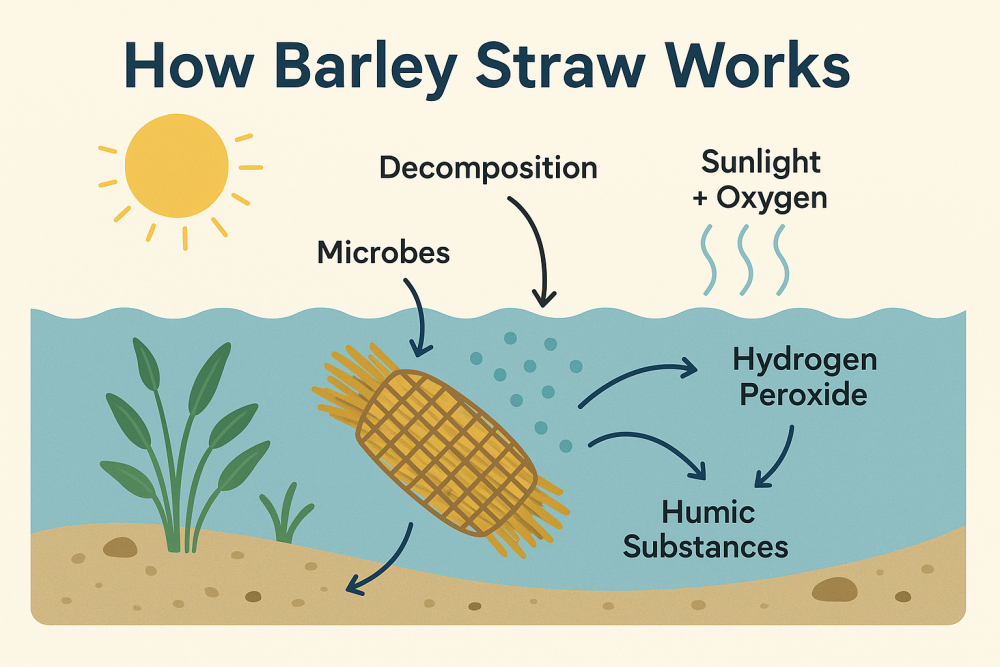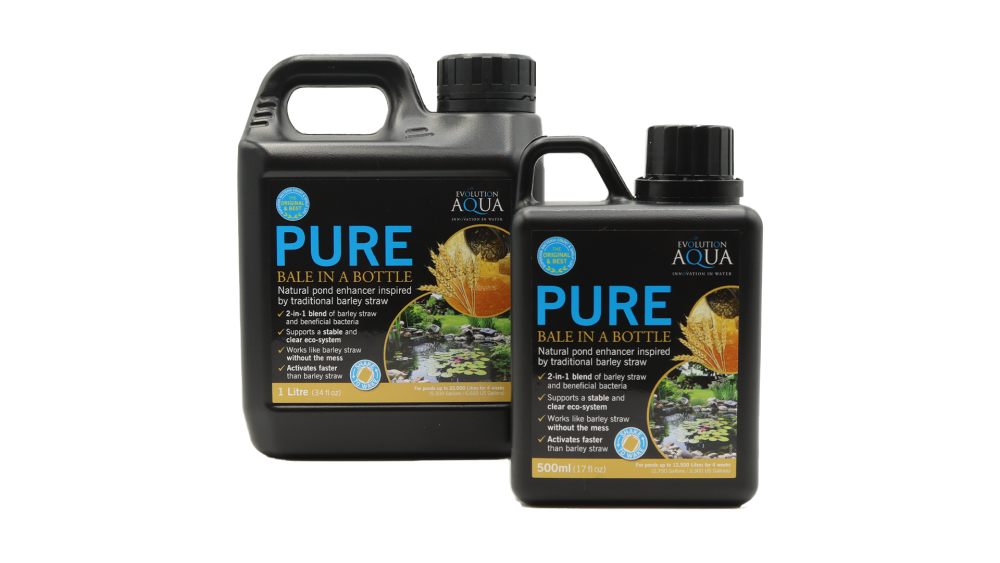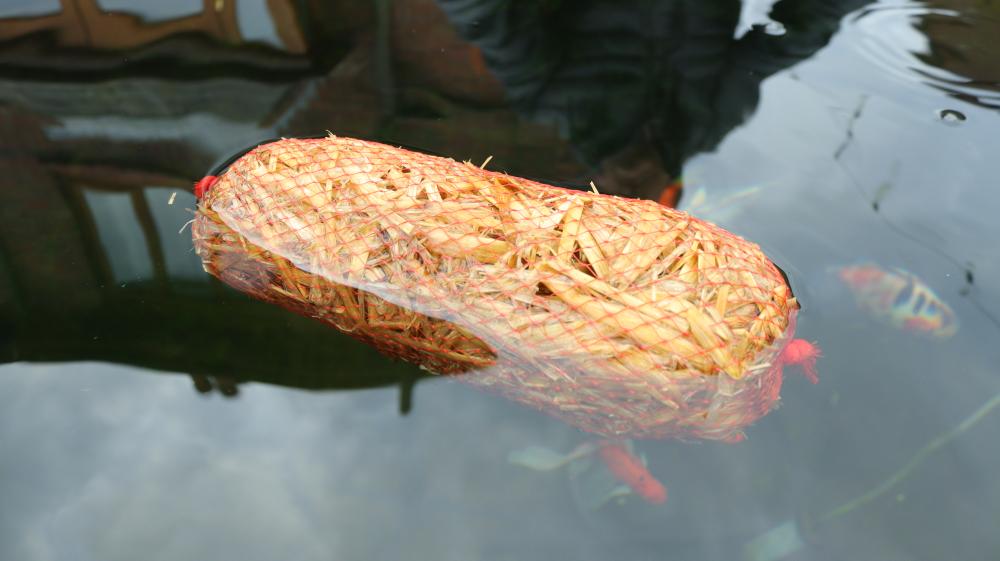Our offices are closed from Wednesday 24th 2025 until Monday 5th January 2026
Orders received after 12:30pm on Wednesday 17th December 2025 will be shipped on Wednesday 7th January 2026
The Science of Barley Straw: How It Stops Pond Blanket Weed

The Science of Barley Straw: How Conventional Barley Straw Bale Combat Blanket Weed
For decades, pond keepers have relied on a deceptively simple solution to fight unsightly blanket weed (filamentous algae): the humble bale of barley straw.
While it may seem like folklore, the effectiveness of barley straw is rooted in a fascinating microbial and chemical process, making it a natural, science-backed approach to pond health. Here is the scientific explanation of how a conventional barley straw bale works to maintain a clear pond.
1. The Critical Decomposing Process
When a bale of barley straw is placed in the pond, it must first begin to break down a process known as decomposition or rotting. This is a microbial process primarily driven by bacteria and fungi in the water.
Crucially, this decomposition requires well-aerated conditions (plenty of dissolved oxygen) to ensure the correct chemical by-products are released. If the straw becomes anaerobic (oxygen-starved), it will not work effectively.
2. The Temperature Factor and Activation Time
The speed at which the straw becomes active is highly dependent on water temperature:
• Warm Water (above 20°C): The microbial activity is fast, and the straw may become active in as little as 1-2 weeks.
• Cool Water (below 10°C): The process is significantly slower, taking 6-8 weeks or more to start releasing the effective compounds.
Because of this delay, barley straw is most effective when used as a preventative measure, added in early spring before blanket weed growth accelerates.
3. The Release of Algistatic Compounds
As the straw's complex cell wall components, such as lignin, decompose, a mixture of organic compounds is released into the water.
These compounds include humic and fulvic acids, which are known to be non-toxic to fish and plants.
The final, key stage of the process involves these compounds reacting with sunlight and dissolved oxygen in the water. This reaction leads to the sustained, low-level production of a powerful inhibitor: hydrogen peroxide H2O2.
4. The Action of Hydrogen Peroxide
Hydrogen peroxide is a potent oxidizer and effective algaecide. Scientific studies have shown that very low, sustained concentrations of H2O2 (as low as 2 parts per million) released from the decomposing straw are sufficient to inhibit the growth of new algae cells.
This is the central takeaway: barley straw is an algistat, not an algicide. It works by stunting and preventing the proliferation of blanket weed and other algae, allowing beneficial organisms and higher aquatic plants to eventually out-compete the algae for nutrients, promoting a healthier, clearer pond ecosystem.

PURE Bale In A Bottle: Modern Science, Instant Results

While the traditional barley bale works, its dependence on slow decomposition, temperature, and aeration often means long wait times and inconsistent results. Evolution Aqua's PURE Bale In A Bottle takes the proven science of matured barley straw and significantly enhances it using modern biological technology.
This unique 2-in-1 gel formula provides all the benefits of traditional barley straw, but with several key advantages:
![]() Fast Acting: The liquid formula is pre-conditioned and activated by a quick shake. Unlike the weeks-long wait for a conventional bale to rot, PURE Bale in a Bottle is designed to start working much faster, providing quicker support for your pond.
Fast Acting: The liquid formula is pre-conditioned and activated by a quick shake. Unlike the weeks-long wait for a conventional bale to rot, PURE Bale in a Bottle is designed to start working much faster, providing quicker support for your pond.
![]() Simple, Controlled Dosage: Forget wrestling with messy, bulky bales. The liquid format allows for easy, simple, and precise weekly dosage, ensuring consistent treatment and maintenance.
Simple, Controlled Dosage: Forget wrestling with messy, bulky bales. The liquid format allows for easy, simple, and precise weekly dosage, ensuring consistent treatment and maintenance.
![]() No Mess, No Debris: The formula delivers the proven results of barley straw without the resulting detritus and debris that can cloud the water and require manual removal.
No Mess, No Debris: The formula delivers the proven results of barley straw without the resulting detritus and debris that can cloud the water and require manual removal.
![]() Added Beneficial Bacteria: Crucially, the gel is enhanced with live beneficial bacteria. These bacteria work alongside the barley extract to boost your pond's ecosystem, improve water clarity, and promote a balanced, healthy environment by consuming excess waste and nutrients that would otherwise fuel blanket weed growth.
Added Beneficial Bacteria: Crucially, the gel is enhanced with live beneficial bacteria. These bacteria work alongside the barley extract to boost your pond's ecosystem, improve water clarity, and promote a balanced, healthy environment by consuming excess waste and nutrients that would otherwise fuel blanket weed growth.
